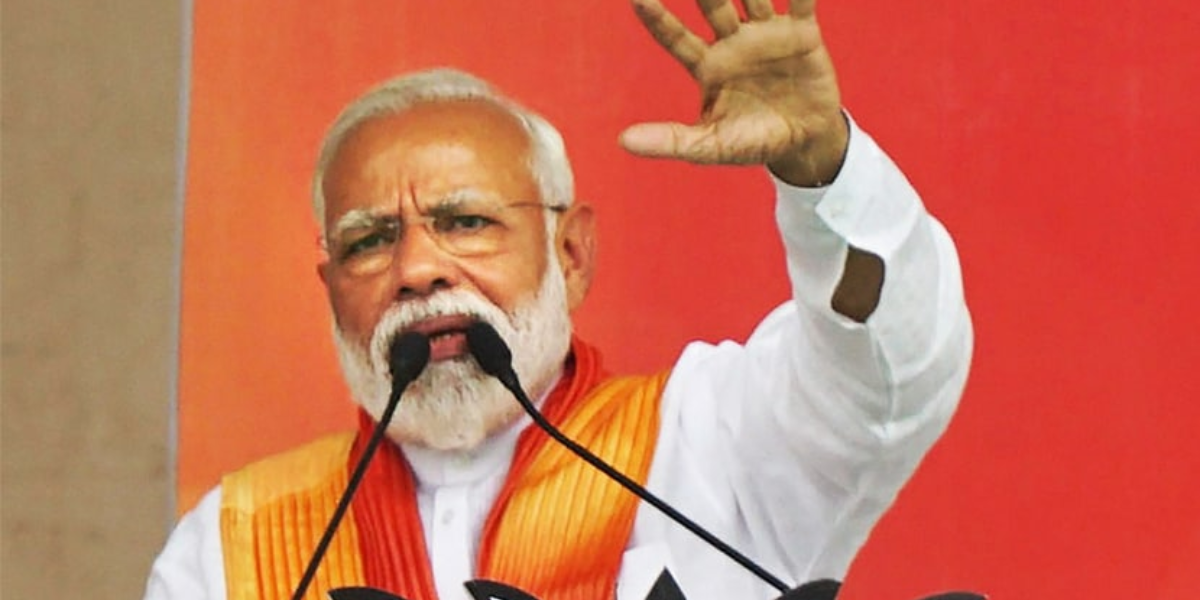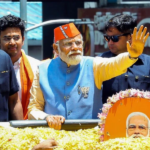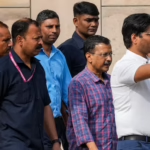India’s Mumbai has a An Indian Muslim guy who is sympathetic to Palestinians is reprimanded by a male journalist on one station. The journalist asks the man, “Did you stand with Hindus when they suffered atrocities in Pakistan and Afghanistan?”
On a different channel, a journalist asks a Muslim citizen of the city of Ayodhya with a joyous tone whether Muslims were pleased that a Ram temple had been constructed on the site of a mosque that had been destroyed by a Hindu nationalist mob.
The female anchor of yet another channel claims that there is a plot in motion to transform the state of Kerala, which is located in the southern region of India, into a “Islamic State.” She claims that the center of this plot is Wayanad, which is the parliamentary seat of Rahul Gandhi, the opposition leader. However, she does not provide any evidence to back up her claim.
YouTube has over 460 million users in India, making it the largest market for the platform. Four out of every five people who use the internet in India consume material from YouTube. More and more people in India are turning to YouTube as their primary source of news dissemination.
What is available, on the other hand, is not always news. Some of the most prominent news programs on YouTube in India are progressively providing a mix of Islamophobia and disinformation. These channels frequently cheerleader Prime Minister Narendra Modi and his party, the Bharatiya Janata Party (BJP), while simultaneously criticizing its opponents and opposition politicians.
A prevalent phenomenon on YouTube is the creation of political content by partisan YouTube influencers that support either side of the political divide. However, what distinguishes these channels from others is that they claim to be “news” channels and ostensibly deliver fact-based coverage.
These channels frequently supplement the efforts that the Bharatiya Janata Party (BJP) is doing in its own campaign. They do anything from criticizing and assaulting Modi’s opponent politicians to spreading conspiracy theories about Muslims seeking to hurt Hindus.
Despite the fact that these networks are not as well-known as mainstream news channels, they have millions of viewers, which gives them a significant role in the manner in which the largest democracy in the world is consuming news as India prepares for its national election.
For example, NMF News, which is ranked among the top 100 news and politics channels on YouTube in India, has more than 18.2 million subscribers and more than 8.1 billion views. Headlines India, which has more than 8.83 million subscribers, has about 3 billion views, while Rajdharma News, which has 3.2 million subscribers, has nearly 0.9 billion views.
Due to the fact that these “news” sites have such a broad reach, there is a growing worry regarding the ways in which they may influence perceptions and opinions, particularly during election season.
Studies have revealed that Indians have a higher level of trust in the news that they view on YouTube and WhatsApp than they do in the news that is supplied by major media sites. This is despite the fact that many people have expressed concern about the role that YouTube plays in spreading misinformation. The World Economic Forum’s 2024 Global Risk Report has already reached the conclusion that the most significant risk that India is exposed to is the fallout that results from the dissemination of misleading information.
Under the pretense of reporting “news,” the majority of these stations, which were studied for this article, habitually spread false information about Muslims, others who disagreed with them, and those who were critical of Modi and the BJP.
According to Pankaj Prasoon, the bureau chief of NMF News in the state of Jharkhand in eastern India, the channel refuted charges of such a bias but asserted that it was the “fastest-growing” channel. Pankaj Prasoon stated that the channel was “sometimes right-wing” in its approach, but that it was always “fact-based.” Both Headlines India and Rajdharma News did not provide a response, despite the fact that they were asked multiple times to provide feedback via publicly accessible emails.
Disinformation, propaganda
As the election campaigning in India heats up, the disinformation that is being broadcast on these channels is also heating up.
On March 13, NMF News released a report on its channel that lasted for three minutes and focused on Jawaharlal Nehru University (JNU), which is located in New Delhi and holds the distinction of being one of the most prestigious universities in India. As a result of the left-leaning student politics at JNU, the Modi government has been focusing its attention on the university. Many people who support Modi have referred to JNU as a “anti-national” space.
This political jargon is rehashed and echoed in the news story that was published by the NMF. The report was headlined “No More Sloganeering in the Anti-National Hub of JNU.” Before going on to promote an upcoming film called JNU, which depicts the politics on campus and has a tagline that is revealing: “Can One Educational University Break the Nation?” the article expresses regret over the fact that the university had, over the course of time, become “the hub of antinational activities.” It attributes this to “the rapid spread of leftist thought.”
Another article is headlined “Amit Shah’s Solid Action Leaves Rahul In Shivers,” and it includes a thumbnail image of Amit Shah, who is a close assistant to Modi and the Home Minister. Rahul Gandhi is depicted with his hands folded. There is yet another video that makes fun of Gandhi for his recent trip throughout the country to meet with supporters.
Diminish critics
NMF is not the only one! The content of six different channels, including NMF, Rajdharma, Headlines India, Shining India, Capital TV, and O News Hindi, was analyzed by Narrative Research Lab, a data lab based in New Delhi that uses artificial intelligence (AI) to track content in print media and social media. The findings of the study revealed that the coverage of India’s opposition parties was muted, and the leaders of those parties were rendered almost invisible. Modi and the Bharatiya Janata Party (BJP) nevertheless, loomed large, and their coverage was nearly invariably favorable.
Between the dates of December 22, 2023 and March 22, 2024, the laboratory examined a total of 2,747 videos that were uploaded to these channels. In their findings, the laboratory discovered that some of the most frequently used words in the titles of all of the channels were “Modi,” “BJP,” and “Yogi.” These words were used to refer to Yogi Adityanath, the hardline BJP chief minister of Uttar Pradesh state. On the other hand, mentions of opposition parties and leaders were used very infrequently.
During the course of a “sentiment analysis” conducted by the laboratory, it was discovered that although the term “Modi” was frequently utilized in movies that had both good and negative sentiments, allusions to India’s opposition stalwarts such as Gandhi were primarily identified in phrases that were negative.
According to Sundeep Narwani, who was one of the co-founders of the Narrative Research Lab, these channels performed a valuable service by acting as “vehicles” for negative targeting.
Narwani stated that these channels have evolved into simple methods of targeting those who criticize Modi and those who are in opposition to him. As a result of the fact that political parties frequently do not wish to engage in such negative targeting, channels of this kind become easy vehicles for doing such targeting.
Between the dates of December 22, 2023 and March 22, 2024, the laboratory examined a total of 2,747 videos that were uploaded to these channels. In their findings, the laboratory discovered that some of the most frequently used words in the titles of all of the channels were “Modi,” “BJP,” and “Yogi.” These words were used to refer to Yogi Adityanath, the hardline BJP chief minister of Uttar Pradesh state. On the other hand, mentions of opposition parties and leaders were used very infrequently.
During the course of a “sentiment analysis” conducted by the laboratory, it was discovered that although the term “Modi” was frequently utilized in movies that had both good and negative sentiments, allusions to India’s opposition stalwarts such as Gandhi were primarily identified in phrases that were negative.
According to Sundeep Narwani, who was one of the co-founders of the Narrative Research Lab, these channels performed a valuable service by acting as “vehicles” for negative targeting.
Narwani stated that these channels have evolved into simple methods of targeting those who criticize Modi and those who are in opposition to him. It is not uncommon for political parties to be reluctant to engage in such negative targeting, which is why outlets like this become convenient vehicles for doing so.”
It is not uncommon for the social media handles of the BJP to post videos from these channels,” he stated. According to him, “In addition, BJP sympathisers use the party’s social media apparatus to disseminate these videos among their cadres.” This helps the channels amplify their reach and, as a result, collect cash from revenue generated from clicks and views.
In the run-up to the Uttar Pradesh state elections in 2022, at least four of these networks, namely Rajdharma News, Headlines India, Shining India, and Capital TV, were granted permission to conduct interviews with Chief Minister Adityanath.
Stoking Islamophobia
Anti-Muslim stereotypes and Islamophobic sentiments are frequently amplified and spread through these means.
Days before Prime Minister Narendra Modi dedicated a temple in Ayodhya to the Hindu god Ram, which had been constructed on the site of a mosque that had been destroyed by a group of Hindu nationalists in 1992, a reporter from Rajdharma News conducted interviews with Muslims who lived in close proximity to the site and asked them leading questions.
It has been reported that Muslims are extremely pleased with the construction of the temple, and that they intend to celebrate the consecration of the temple as if it were Diwali festivities. “Is that a fact?” This question was posed by the reporter in reference to the well-known Hindu holiday.
In the early 1990s, during the drive sponsored by the BJP to construct a temple at the location, there was violence that resulted in the deaths of up to 2,500 people (PDF). In spite of this, the reporter poses difficult questions to Muslims who are present in the city. In addition, the reporter mentioned that there are Muslims who believe that Ram was also their ancestor. “Do you think Muslims will maintain peace on January 22?” he asks another, referring to the day that the temple is dedicated. “January 22” is the date that the temple is dedicated.
It was in July of the previous year when areas of the state of Haryana in the north were affected by sectarian violence between groups of Hindus and Muslims. In the course of reporting on the rioting, another Rajdharma reporter approached an old Muslim man and inquired as to whether or not he was experiencing any symptoms of illness. Upon receiving a positive response from him, she retaliated by asking in a mocking manner, “Why? In reference to the day of the conflicts, “Did you put in an excessive amount of effort on July 31?”
She continued by saying, “Tell me one thing: wherever Hindus are in the majority and Muslims are in the tiniest minority, we, Hindus, do everything to make them [Muslims] feel like kings.” Muslim people are in the minority. “Why do you guys threaten and intimidate followers of the Hindu religion, and why do you cause them so much trouble?” A significant number of people shared the video across various social media platforms, and it received close to 780,000 views on YouTube alone.
A video with the title “A Part of the Country Where Hindu Women Are Delivering Muslim Children” was released by NMF News on March 13th. In it, the anchor, Namrata Chaudhari, made the accusation that “Muslim infiltrators” were seducing tribal women into marriage in the Dumka district of the eastern state of Jharkhand and subsequently “capturing tribal lands.”
In the video, Prasoon, who is the head of the NMF bureau, asserts on multiple occasions that Muslims have flipped the demographics of the region’s population.
In 2011, Muslims made up only 10 and 11 percent of the population, whereas tribal people made up 35 percent. But by the year 2022, there has been a reversal of roles; Muslims now make up 35 percent of the population, while tribal people make up only 10 to 11 percent,” he claimed, echoing a conspiracy theory that is not supported by any evidence that Muslims are conspiring to outnumber Hindus in India.
During an interview with Al Jazeera, Prasoon was unable to give a source for the assertion that Muslims constitute a larger population than tribal people. When it was brought to Prasoon’s attention that India has not conducted a census since 2011, he stated that the data he supplied for the year 2022 was based on “estimates.” He also stated that he “might” have quoted Nishikant Dubey, a controversial member of parliament for the BJP, who claimed that there had been a demographic shift. In December of the previous year, Dubey had made the claim that “illegal Bangladeshi immigrants” were to blame for the demographic shift that had occurred in Jharkhand, but he did not provide any evidence to support his assertion.
As stated in a different video, Prasoon stated that the Islamic State of Iraq and the Levant (ISIL) was establishing “colonies” in the Wayanad region of the state of Kerala in southern India, where “even patriotic Muslims” were not permitted to enter. These allegations were disputed by the Wayanad police, who had even taken legal action against another web page for distributing “false information” about the locality being discussed.
In the video, Prasoon asserted that Muslims and Christians made up up to 80 percent of Wayanad’s population, while Hindus served as a minority. This is despite the fact that data from the government reveals that Hindus constitute 49.5 percent of the region’s population, while Muslims constitute 28 percent of the region’s population.
In response to a question, Prasoon stated that the National Media Foundation incorporates local news reports into its reporting.
I am unable to recall the specifics of that video, nor can I recall where I obtained that statistic. I could have reported the most recent population numbers from a source other than the Census,” he claimed, but he insisted that his channel’s reporting was always factual. He did not name the source, but he did indicate that he could have done so. According to him, “NMF” is an acronym that stands for “News Means Facts,” which means that we always make sure that we have documentary support for our statements.
According to Madhav, the journalist who has reported on these YouTube channels, such video is then exploited by right-wing parties to support and restate the agenda of the Hindu majoritarian movement.
According to Madhav, “These channels frequently feature stereotypical characters such as a Muslim who despises other Muslims but loves Modi, or a Muslim woman who discusses atrocities committed against other Muslim women.”
The analysis conducted by the Narrative Research Lab also discovered that there was an increase in the quantity of videos that these channels created on events such as the day when the controversial Citizenship Amendment Act guidelines were announced on March 11. Hindus, Parsis, Buddhists, Jains, and Christians from neighboring Muslim nations are granted Indian citizenship more quickly as a result of these laws; nevertheless, Muslims are not permitted to participate in the process.
According to Narwani, who works at the lab, “the content trend observed here is that all of the channels… have a similar audience base and that they might be trying to push and reiterate a certain uniform narrative on the issue.”











